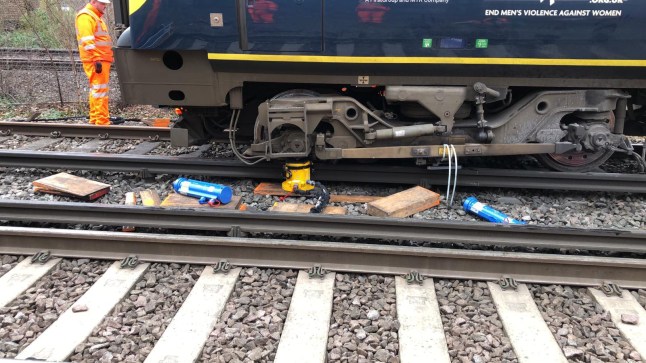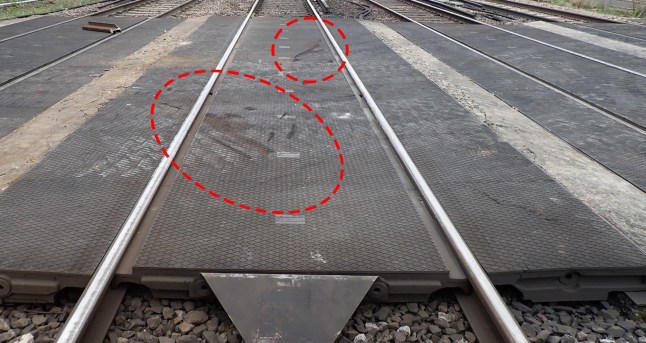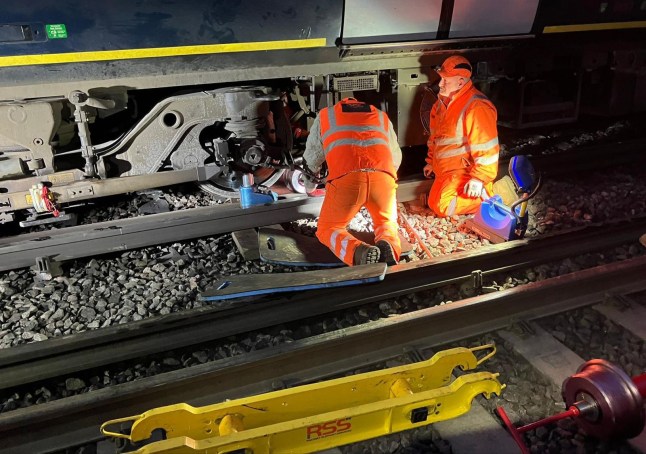London train derailed at 85mph after colliding with a piece of rail
A passenger train derailed in Surrey after it hit an object that was mistakenly left behind.
A train driver and passengers had a narrow escape after the train struck a piece of redundant track on March, 4, last year at high speed on approach to Walton-on-Thames station.
The London-bound train was travelling at 85mph when it crashed into the rail, causing the front coach to derail.
The South Western Railway train stopped around 1,600 feet (500m) from the point of derailment after the sudden contact at high speed.

The SWR train blocked the railway line for hours after it derailed, causing travel disruption (Picture: Network Rail)
While there were no injuries, the train could have ‘easily’ struck other trains or objects, a chief rail accident investigator said.
Passengers were escorted out unhurt while engineers began to replace the broken track and damaged power and signalling cables.
The accident caused issues for passengers after the railway was blocked for hours. One woman said on social media she was unable to travel to Somerset to scatter her father’s ashes because trains were disrupted.
Now, the railway watchdog has revealed what led to the crash, which happened at about 5.40am.
The piece of redundant railway was left on the tracks following work in the area despite checks, a report by the Rail Accident Investigation Branch said.
This could happen because ‘no person in charge had supervised the work and because a track handback engineer had not been effectively briefed as to what work had been undertaken before they inspected the track,’ the report said.

The red circles mark the area where the train derailed on approach to Walton-on-Thames station (Picture: Crown copyright/Rail Accident Investigation Branch)
The checks after the work failed to identify that the piece of redundant rail ‘was in a potentially hazardous position.’
Andrew Hall, the chief inspector of rail accidents, said that although one was hurt in the Walton-on-Thames accident, the train could ‘easily have deviated from the line of the track and struck other trains or objects.’
Overnight maintenance work makes ensuring the line is safe for passage ‘particularly challenging’ and the ‘risk is very clear,’ he said.
‘Unfortunately, this accident happened because that risk was not effectively managed. This, following other similar recent incidents, should serve as a stark reminder of the importance of effectively managing the risk of objects being left on the track after overnight maintenance,’ he added.

Engineers installed skates to lift the damaged wheel off the rail so that the train could be towed away (Picture: Network Rail)
The watchdog described the work site as ‘complex’ and said that arrangements for work planning and delivery ‘did not effectively manage the risk of a section of rail being left foul of the running line.’
Martin Frobisher, Network Rail’s safety and engineering director, told Metro: ‘Safety is always our first consideration. The most recent independent international data shows that Britain has the safest railway in the world and during the last year we have achieved the railway’s lowest ever workforce accident rate.
‘However incidents such as the derailment at Walton-on-Thames clearly show us that there is no room for complacency.
‘Since the incident, we have introduced strict new protocols to make sure this can’t happen again. We will be reviewing the RAIB’s recommendations in detail and will continue to do all we can to make our railways the safest they can be.’
Read more similar news:
Comments:
comments powered by Disqus


































